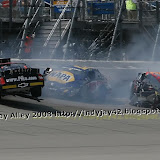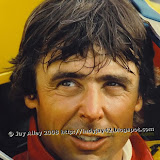
I have held off writing the last few days to see if I was going to awake from a dream and discover the rumors about an open wheel reunion had been a nightmare. But the dream lives on after all, and despite what many on the internet are saying, Tony George has made it happen at long last. I for one do not think it is too late for Indycar racing to regain its prestige and reputation on the US sporting scene.
So go buy a ticket! Get to a race. Or STFU.
Bash Tony all you want but anyone that follows open wheel racing in America must know that the bankruptcy judge did no one any favors when he bypassed George for Kahlkoven's lower offer a few years ago. Let's face it folks, Indy is the goose that laid the golden egg, and Tony has some spare change now that he doesn't have to feed the F1 greed machine anymore. Hasta la vista, Bernie. Welcome back Paul Newman.
Granted, the bleeding has been severe since the first IRL season in 96, and perhaps the fan base won't recover. But at least everyone is together again. I expect 2009 to be a spectacular season, while the series will experience teething pains this year.
I hold out hope for a number of positives. Perhaps the teams will actually share info and parts, as in years past when new teams were struggling to find speed. I'm sure Dallara has a base setup that everyone will get, and Indy will provide lots of track time for teams to sort themselves out.
Lord knows plenty of guys have gotten up to speed in May with unfamiliar equipment and part time crews in the past, so there's no doubt in my mind that the Champ Car guys will adapt. And much more quickly than many may expect. The established IRL teams will still have an advantage this year, but adding a couple more open tests should help everyone get with the program.
I also think we will hear the CCWS guys glad to be back at Indy. Paul Tracy will even have to admit he wants another shot at Helio, and I doubt he will say that Indy "owes" him one.
Newman Haas will be a force to reckon with, especially for the 500. Rahal and Wilson will have no problem going fast in May.
Derek Walker will somehow find some cash and get a car in the show at IMS. If Greg Beck can do it every year, then surely someone with Walker's savvy will be on the pace in a hurry. After all, he beat everyone a few years ago at Mid Ohio on strategy with the Porsche program that couldn't get out of its own way anywhere else.
With Australia and Edmonton on the schedule, the international fans will be treated to the best open wheel competition anywhere once again. I challenge anyone that would say there's a racier series this year, and don't feed me the F1 techno line as those guys don't race. Indycars do.
I can't wait for May and I wish I could get to Florida for the Homestead and St. Pete races, but my summer will be busy in the Midwest with the middle portion of the IRL schedule. It's really even more of a shame now that Michigan is gone from the schedule, as that is the one track where these cars really can stretch their legs and fans can see the whole show from the stands.
I do have a couple of other questions:
When will Tony Stewart come back?
And, is it May yet?




